Whether your goal is to increase chest muscle size, improve the strength of the chest muscles, or your training for general health and well-being, training the chest is a must. We have our own set of favorites that we’ll share, but keep in mind that the best chest exercises for you will vary based on your fitness level, preferences, and unique factors about you that influence how you respond to exercise.
In our opinion, the best chest exercises are the Flat Bench Press, Incline Bench Press, Dip, Decline Bench Press, Dumbbell Flys, Standing Cable Fly, Cable Crossovers (Upper Chest),, Machine Chest Press, and Push Up.
Before we take you through the specifics of each type of exercise, let us first get familiarized with the muscle group we’re targeting: chest muscles.
What Are Chest Muscles?
No part of the body works independently from the rest, so to understand how the chest muscles work, we need to explore how they relate to the body as a whole. First, some anatomy.
The human skeleton is broken up into axial and appendicular portions. The axial skeleton is made up of the skull, the vertebrae of the spine, the ribs, and the sternum, whereas the appendicular skeleton includes the limbs and their respective girdle that attach the limbs to the axial skeleton. [1] Using the arm as an example, the shoulder girdle (sometimes called a pectoral girdle) is made up of two bones: the clavicle (collarbone) and scapula (shoulder blade). These two bones interact with the humerus (upper arm bone). Together, the bones of the shoulder girdle and axial skeleton serve as attachment points for muscles that cause the humerus to move during activity.
The shoulder girdle is made up of a ton of different muscles, as the scapula and the humerus attach to 17 and 13 different muscles, respectively. [2,3] When focusing on the muscles of the chest specifically, we’re looking at the muscles that connect the arm to the anterior (front) and lateral (side) thoracic wall. For completeness, the thoracic walls enclose the space between the neck and the diaphragm and is where the lungs and heart are. The space below the diaphragm running to the pelvis is the abdominal cavity, which is where organs like the liver, kidneys, and the intestines reside. [4]
Now that we have covered the regional anatomy of the body, let’s focus on the muscles of the chest that connect the front and side of the thorax (chest) to the humerus: the pectoralis major, pectoralis minor, serratus anterior, and subclavius:
- The pectoralis majoris the biggest muscle of the chest. In men, it is situated underneath the skin and subcutaneous fat. In women, it is located below breast tissue. There are two heads to the pectoralis major; the clavicular head that arises from the clavicle and the larger sternocostal head, which arises from the sternum, the upper costal cartilages of the ribs, and the sheet-like tendon of the external oblique muscle. [5]
- Found right below the pectoralis major, the pectoralis minor is a triangular-shaped muscle.
- The serratus anterior is a fan- or serrated-shaped muscle starting from the sides of the first eight or nine ribs and running to the scapula.
- The subclavius muscle is a short triangular muscle lying underneath the clavicle.
While each of these muscles is different in size and shape, they all help you move your arms in a coordinated fashion. Specifically, these muscles act on the humerus and/or or scapula to create movement of the upper limb. When a muscle crosses a joint, it has the potential to cause movement of that joint, though the resulting movement of the arm depends on many factors. In anatomical terms, these movements are called:
- Internal rotation: Turning the humerus about its vertical axis towards the midline of the body is called internal rotation of the humerus.
- Flexion: Moving the arm forward is called shoulder flexion or flexion of the humerus.
- Extension: Moving the humerus backwards is called shoulder extension or extension of the humerus.
- Adduction: Moving the humerus inwards towards the midline of the body is called adduction of the humerus.
- Protraction: Moving the scapula laterally and forward towards the front of the body is called protraction.
Best Chest Exercises
- Flat Barbell Bench Press
- Dumbbell Bench Press
- Incline Bench Press
- Dips
- Decline Bench Press
- Dumbbell Flyes
- Standing Cable Flyes
- Cable Crossover
- Machine Chest Press
- Push-Up
Each of these exercises targets the chest muscles as primary movers, but they also use other muscles called synergists. [6] Much has been said of different chest exercise variations producing different results, e.g. more or less growth overall or in a particular area. Unfortunately, the vast majority of these claims are either fabricated or speculation based on mechanistic data.
For a moment, let’s consider the angle of the bench press, as it gets a lot of attention when it comes to discussing both muscle growth and strength development. A number of studies have investigated the electrical activity, eg “excitation”, of the anterior deltoid, pec major (and parts thereof) , and other muscles during flat, incline, and decline bench press with mixed results.
One study found no significant differences in excitation levels of the pectoralis major, anterior and posterior deltoid, or latissimus dorsi muscles during 6-Repetition Maximum efforts on flat, incline, and decline bench presses. [7] A similar study found no statistically significant differences in pectoralis major, anterior deltoid, or lateral deltoid excitation when comparing flat bench press to decline or incline bench, regardless of whether dumbbells or barbells were used. [8] While other studies have found EMG differences (a measure of muscle excitation) using different bench angles, these differences are not really predictive of actual outcomes, e.g. differences in muscle size and strength when using one or more variation(s) over the other. [9]
When it comes to outcomes we care about like chest muscle hypertrophy or strength, the scientific evidence isn’t much better. For example, another study found that there were no meaningful differences in pec major hypertrophy or pressing strength after 8 weeks of doing only flat bench, only incline bench, or both flat and incline bench presses. [10] Finally, a study comparing 4-weeks of doing either push-ups or bench press three-times a week showed similar improvements in both 1RM bench press strength and chest hypertrophy. [11]
All this to say, most chest exercises are likely to produce similar results provided they work the muscle through a relatively large range of motion, using a load that gets the individual within 3 to 4 repetitions of failure within ~ 3 to 20 repetitions.
We recommend considering your individual fitness level, your preferences, and which synergists you’d like to prioritize when choosing the best chest exercise(s) for you. In general, but not always, the muscle excitation of the pectoralis major (and its upper clavicular portion) and the anterior deltoid goes up as the bench angle becomes more vertical. As the bench angle goes down, the muscle excitation for the middle (sternocostal) and lower portions of the pectoralis major increases. The latter is particularly true with a decline bench press.
1. Flat Barbell Bench Press
The barbell bench press is a classic exercise performed by many gym goers, as it trains the pecs, shoulders, and triceps. It’s great as a stand-alone activity or as an addition to your already existing workout if you’re looking to increase muscle mass or strength. Equipment-wise, you’ll need a barbell, a bench, and a squat rack. Alternatively, a fixed-upright bench press “rack” will work.
The barbell bench press is ideal both for beginners and advanced lifters alike, as it is a potent exercise for pressing strength and building size in the pressing muscles. It’s also one of the competitive lifts in powerlifting, making it a favorite among lifters of all fitness levels.
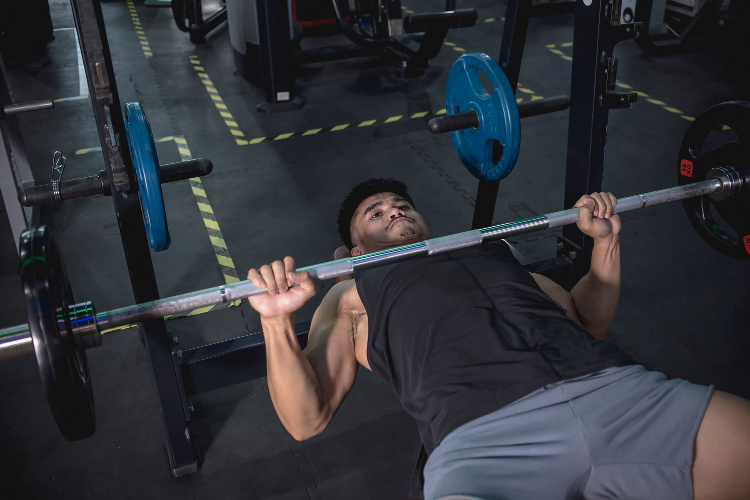
Flat Barbell Bench Press Instructions
- Lay down on the bench with your head slightly in front of the barbell if viewed from the side. This helps ensure there’s enough room for the bar to move up and down without hitting the rack.
- Grab the bar with an overhand grip, using a grip width that’s about 1- to 2-hand widths’ outside your shoulders. (See below)
- Before lifting the bar out of the rack, fix your eyes on a point on the ceiling somewhere just in front (towards your feet) of the bar and pull your shoulder blades back into the bench.
- Lift the bar out of the rack and let it settle just over the shoulder joint.
- Take a big breath and hold it.
- Bring the bar down to touch your sternum, approximately 2 to 3” forward of where the bar started over the shoulder joint. In this position, the elbows and humerus should be angled at ~ 30 to 45 degrees relative to the torso.
- Press the barbell up and back so that it ends up directly over the shoulder joint.
Pro Tip:
Grip width is mostly personal preference, as some prefer closer or wider hand placement. In general, the wider the grip width, the more the elbows will be “flared” directly out to the sides and the higher on the chest the bar will touch. Similarly, the closer the grip is, the lower the bar will touch on the chest and the more the elbows will be “tucked” into the sides. Check out this video for more in-depth instructions.
2. Dumbbell Bench Press
A variation of the barbell bench press, the dumbbell bench press helps build not only your pecs, but also synergist muscles like your triceps and deltoids, along with placing greater demands on stabilizing muscles responsible for coordinated movements of each arm independently . It’s great as a stand-alone activity or as an addition to your already existing workout if you’re looking to increase muscle mass or strength. Equipment-wise, you’ll need a pair of dumbbells and a bench.
The dumbbell bench press is ideal both for beginners keen to start building up strength or more advanced lifters interested in improving their stability. This versatility makes the dumbbell bench press an absolute favorite among lifters of all fitness levels.
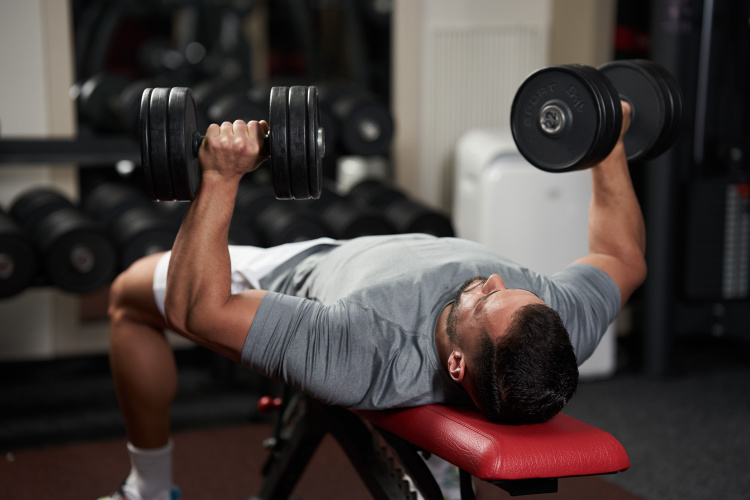
Dumbbell Bench Press Instructions
- Pick up the dumbbells with your hands facing in and with a neutral grip.
- Sit on the bench with the dumbbells’ ends inside your hip crease. Lay back and hold the weights near your chest to position yourself.
- Once you’re ready, take a deep breath, and then press the dumbbells to lockout at the top. Lower the dumbbells slowly and with control until the handles are roughly the same level as your chest.
- Push the dumbbells back up to the beginning position while contracting your chest.
Pro Tip:
Make sure your feet are always flat and pressing into the ground. This helps keep your body from moving.
3. Incline Bench Press
Yet another variation of the bench press, the incline bench press develops the chest and triceps muscles along with synergists like the anterior deltoid of the shoulder. While many claim that the incline bench press focuses more on the upper pecs and shoulders than flat bench press exercises, this is not really supported by evidence. [7,8,10,11] That said, the incline bench press is a fine pressing exercise that can be included in either your chest workout or your full-body routine. The angle of the bench press is mostly personal preference. For strength purposes, a lower incline (e.g. 15 degrees relative to horizontal) is likely to transfer better to a flat bench press. In contrast, a higher incline (e.g. 45 or 70 degrees) is likely to transfer better to an overhead press. In terms of equipment, you’ll need a barbell and an incline bench.
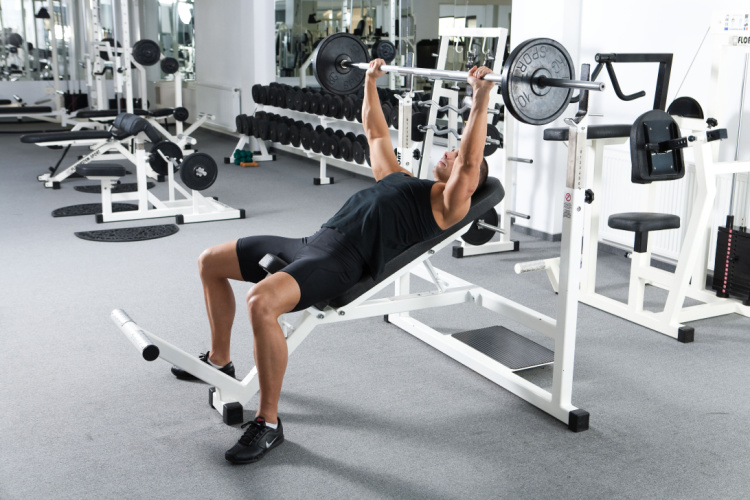
Incline Bench Press Instructions
- Lie down flat on your back on an inclined bench. Place your hands about 1 to hand widths’ outside what would otherwise be shoulder-widtht on the barbell.
- Fix your shoulders by pinning your shoulder blades together and pressing them onto the bench. Take a deep breath. Let your spotter help you with the lift-off so that your upper back remains firm.
- Allow the weight to settle, and make sure your upper back is still tight after lift-off.
- Take a breath and let the bar descend gradually by unlocking your elbows. Bring the bar down in a relatively straight line to the upper part of the sternum and touch the chest.
- Next, push the bar upward again in the same straight line while pressing your body onto the bench, pressing your feet firmly on the ground, and extending your elbows.
Pro Tip:
Similar to other pressing exercises, make sure the shoulder blades are still retracted into the bench and not moving as you press up.
4. Dips
The dip primarily targets the pectoralis major and minor, anterior deltoid, and triceps. Similar to the claims regarding which bench angle is best for strength and hypertrophy, the dip can be performed at different angles as well. Some claim that doing a dip with a more vertical torso targets the shoulders and triceps more, whereas doing the dip with a forward-leaning torso is said to use more chest. Again, these claims are mostly speculative and as such, we would recommend trying both styles and seeing what you prefer and respond best to.
This exercise can be performed using only your body weight, added weight in the form of a dip belt with weight, chains, or even weighted vests depending on the rep scheme being used and an individual’s strength level. They can even be done using assistance from a band or Gravitron machine.

Chest Dip Instructions
- Grip the parallel bars at the dip station slightly wider than shoulder-width, hands facing in.
- Press up to support your bodyweight using your chest and arms.
- Tilt your body forward and lift up your legs. You may choose to cross your legs at the ankles, as this can improve balance for some.
- Start the dip by unlocking your elbows to allow your torso to move down and forward. The amount of forward lean of the torso used can alter how the exercise feels, though again, it’s unclear whether or not this produces different effects in strength and size.
- Continue downward until the front of the shoulder is below the top of the elbow, then raise yourself up until your arms are straight.
Pro Tip:
Don’t let your head jut forward during descent.
5. Decline Bench Press
The decline bench press is another variation of the bench press that primarily targets the pectoralis major and synergists like the anterior deltoid and triceps. There’s some evidence suggesting the decline bench press may engage the lower portion of the pectoralis major (sternocostal head) to a higher degree than a flat or incline bench press and relatively less excitation of the anterior deltoid. [12,13] Similar to other chest exercises discussed so far, it is unclear that this particular variation produces significant differences in muscle size gain relative to others.
For this exercise you’ll need a decline bench set to about -15 degrees relative to horizontal. It can be done with a barbell using a decline bench “rack” or with dumbbells and an adjustable bench.
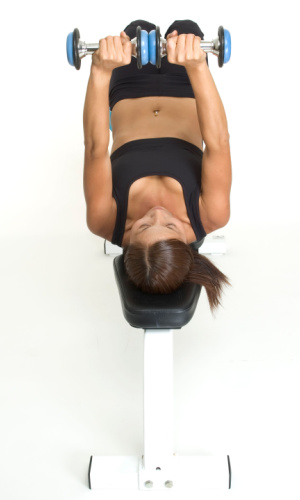
Decline Bench Instructions
- Lie down flat on your back on a decline bench. Place your hands just about 1- to 2- hand widths’ wider than what would otherwise be shoulder-width on the barbell.
- Fix your shoulders by pinning your shoulder blades together and pressing them onto the bench. Take a deep breath. Let your spotter help you with the lift-off so that your upper back remains firm.
- Allow the weight to settle, and make sure your upper back is still tight after lift-off.
- Take a breath and let the bar descend gradually by unlocking your elbows. Bring the bar down in a relatively straight line to approximately the lower part of the sternum base and touch the chest.
- Next, push the bar upwards and back to where the bar is directly over the shoulder joint with your elbows locked out.
Pro Tip:
If using dumbbells, a spotter can be useful to help get the weights into position.
6. Dumbbell Flyes
Dumbbell flyes are considered a single-joint exercise for the chest. Unlike multi-joint exercises like barbell and dumbbell bench presses that involve movements of the shoulder and elbow joints, dumbbell flyes focus on movement of the shoulder and minimal movement of the elbow.
In general, multi-joint exercises use more muscle groups and heavier weights than single-joint isolation exercises. These features of isolation exercises tend to allow an individual to target specific muscles more readily with less fatigue being generated from training. [14] Together, this makes isolation exercises like dumbbell flyes a great movement to include when muscle size is the goal.
From a muscle targeting standpoint, data measuring muscle excitation (EMG) shows that dumbbell flyes rely heavily on the pectoralis major, biceps brachii, and anterior deltoid. Compared to the bench press, dumbbell flyes use relatively little triceps brachii to complete the exercise. [15]
If increasing the size of your chest is the goal, we recommend that you include the dumbbell fly as part of your chest workout, regardless of whether you’re a beginner or a more advanced lifter. To do the exercise, you’ll need dumbbells and a bench.
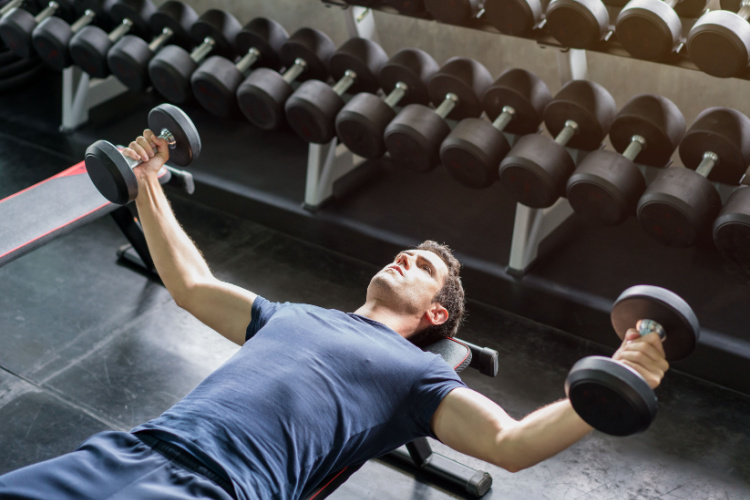
Instructions for Dumbbell Flyes
- Lie on your back on an incline bench. Place your feet on the ground on either side. Keep your head and back pressed onto the bench during the entire activity.
- Have a spotter assist you by giving you two dumbbells (or pick them up yourself).
- Lift your arms above your head so that they’re stretched but aren’t locked out.
- Make sure your palms and dumbbells face one another and that there’s a bit of a bend at your elbow.
- Take a deep breath and gradually lower the dumbbells out to your sides in an arc motion until they’re aligned with your chest. Extend the arms to both sides, but again, don’t lock them out. Your arms should end up being about level with the chest and shoulders at the bottom.
- Think about pulling the dumbbells “up” and “back together” to reverse the motion. The dumbbells should be directly above the shoulder joint at the top.
Pro Tip:
While doing the activity, we recommend a tempo of two seconds down and two seconds up to help control the movement. .
7. Standing Cable Flyes
Similar to dumbbell flyes, standing cable flyes are another single-joint exercise that focus on the pectoralis major, anterior deltoid, serratus anterior, and to some extent, the biceps brachii. The big difference between this and say, dumbbell flyes, is that the standing variation does not use a bench for support of the torso during the exercise, resulting in lower weights being used and some additional demands from the trunk or core. For these reasons, it’s probably better suited for more experienced trainees seeking increased chest muscle size. Equipment-wise, you’ll need access to a pair of adjustable cables.
. Equipment-wise, you need a cable.
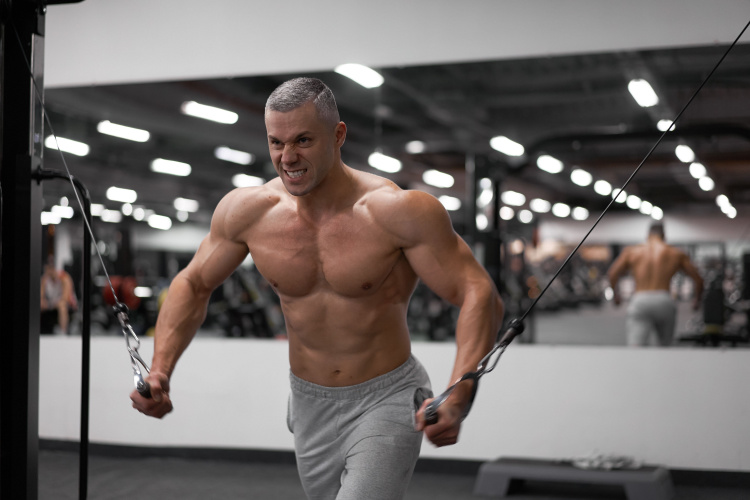
Standing Cable Fly Instructions
- Choose your preferred weight and position both cables at shoulder height.
- Stand with your back to the cable machine.
- Take the handles and hold them with your palms facing forward. Lock your shoulder blades back and down.
- Push forward with your hands in an arching motion until they touch.
- Try not to slouch your back, jut your chin forward, or shrug your shoulders.
Pro Tip:
Similar to other flye exercises, we recommend maintaining a soft bend in the elbows at all times.
8. Cable Crossover
The cable crossover is another single-joint exercise that is very similar to cable flyes The biggest difference here is that instead of bringing the hands together at the top of each rep, the range of motion is extended as the hands are allowed to crossover each other. This additional range of motion may increase the training of the serratus anterior and pectoralis major, as there is greater humeral adduction (pectoralis major) and scapular protraction (serratus anterior) in this movement. Additionally, changing the angle of the torso and/or the height of the cables may change which muscles are targeted similar to changing the angle of the bench press. As the name suggests, you’ll need a cable machine to perform the cable crossovers exercise.
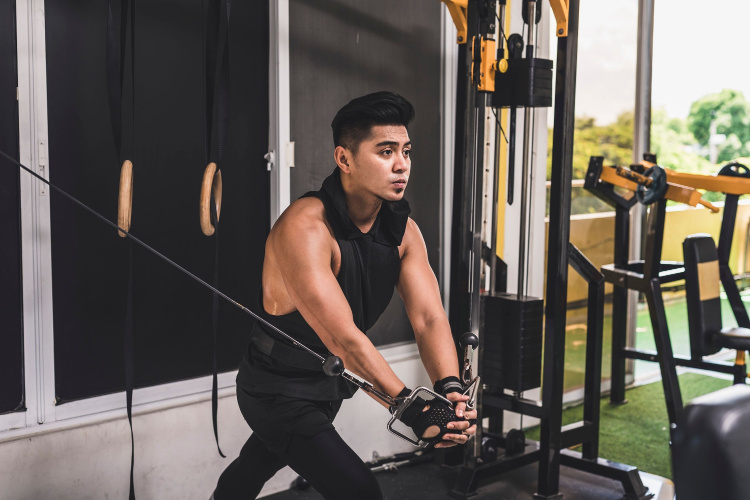
Cable Crossover (Upper Chest) Instructions
- Raise the handles on both sides to their highest position and connect the single grip handles.
- Put your preferred weight on the stacks, and hold each handle with your palms facing down.
- Take a step forward.
- Keep your chest high and your eyes forward while somewhat bending your arms at the elbows.
- Pull the two cables in an arc around your chest, allowing the hands to crossover each other at the end of the range of motion.
- Hold this position for a second.
- Afterward, gradually let your arms go back to the initial position until you sense a stretch in your pecs as you inhale.
Pro Tip:
Again, we would recommend maintaining a soft bend in the elbows the whole time.
9. Machine Chest Press
The machine chest press is, as the name implies, a machine-based variation of the bench press. We’d expect similar muscles to be recruited and trained, e.g. the pectoralis major, anterior deltoid, and triceps, though there’s likely less recruitment of stabilizer muscles in the upper back and trunk compared to a free weight bench press. That said, using a machine variation can still increase pressing strength and muscle size, though the strength improvement is likely to be most significant in machine-based pressing exercises and not free-weight exercises. [16] In this way, strength is specific.
Equipment-wise, you’ll need access to either a Hammer Strength-type chest press machine or a smith-machine and a bench.
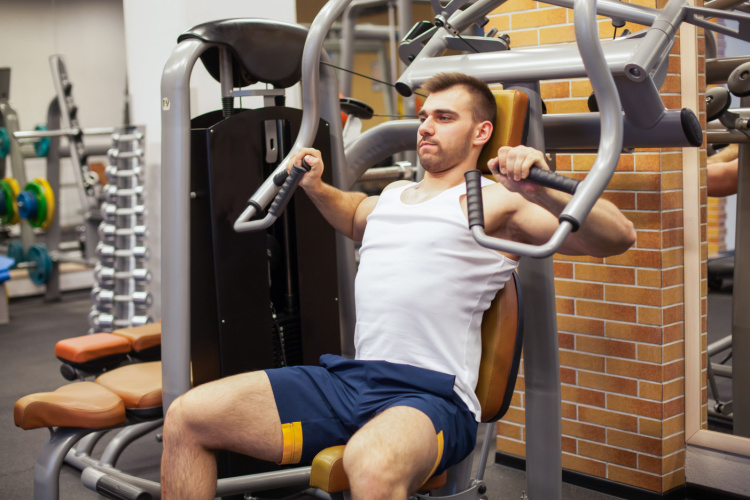
Machine Chest Press (Smith Machine) Instructions
- Place a bench in the smith machine. The “head” of the bench should be oriented so that you’ll be rotating your wrists “back” to unlatch the locking mechanism of the smith machine.
- Lay down on the bench with your head slightly in front of the barbell if viewed from the side.
- Grab the bar with an overhand grip, using a grip width that’s about 1- to 2-hand widths’ outside your shoulders.
- Fix your eyes on a point on the ceiling somewhere just in front (towards your feet) of the bar and pull your shoulder blades back into the bench.
- Unlatch the bar by rotating your wrists backwards.
- Take a big breath and hold it.
- Bring the bar down to touch your sternum, approximately 2 to 3” forward of where the bar started over the shoulder joint. In this position, the elbows and humerus should be angled at ~ 30 to 45 degrees relative to the torso.
- Press the barbell up until the elbows are locked out. Keep the shoulders placed firmly against the bench.
Pro Tip:
Avoid bouncing the bar off your chest at the bottom. Rather, control the bar down and up in a smooth motion.
10. Push-Up
Even if you haven’t exercised a day in your life, you’ve likely still heard of push-ups. Push-ups are one of the most popular exercises, as they can be done anywhere without additional equipment. While most people know what push-ups are, we think that they’re a bit underrated for strength and size.
One common question surrounding push-ups is how much weight is an individual actually lifting? When tested, a regular push-up requires an individual to lift ~64% of their bodyweight, whereas a kneeling push-up uses ~49%. [17] Additionally, we do have other data showing that push-ups can drive increases in chest muscle size and strength to similar levels as the bench press.
For example, a research group out of Japan compared hypertrophy outcomes between the bench press and push-up in 18 young men who had been resistance training for at least 1 year prior. Subjects were split into either bench press (n=9) or push-up (n=9) groups. The bench press group performed 3 sets to failure, 2x/wk, using 40% of their 1RM. The push-up group performed kneeling push-ups, also for 3 sets to failure, twice per week. Both groups showed significant hypertrophy in their triceps and pectoralis muscles with an increased muscle thickness of ~3 mm at each location.There were no significant differences in hypertrophy improvements between the groups. [18] Another study comparing 4-weeks of doing either push-ups or bench press three-times a week showed similar improvements in both 1RM bench press strength and chest hypertrophy. [11]
Like most other pressing exercises, push-ups train your pectoralis major and pectoralis minor muscles, along with the triceps, and anterior deltoids, though they train the core by requiring the individual to maintain a quadruped position. You can add push-ups in your chest routine, push workouts, or entire-body workouts. Equipment-wise, you only need your body weight.
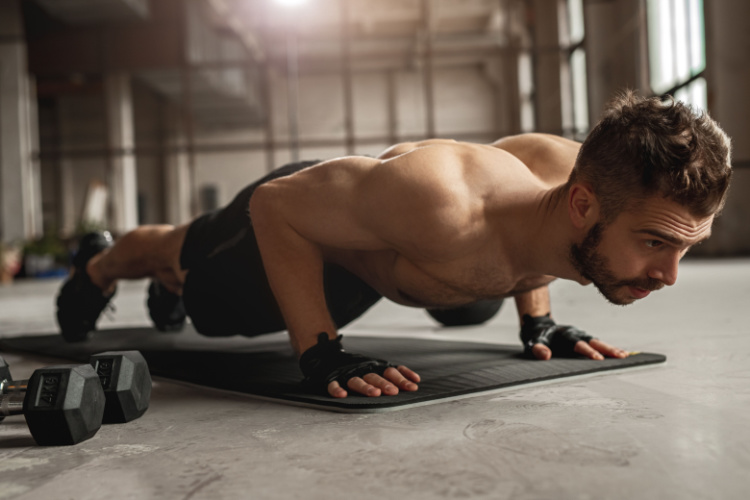
Push-Up Instructions
- Take a quadruped (table-top) position. Make sure your hands are under your shoulders, your knees below your hips, and your toes are tucked. Your arms should be straight, and your head in a neutral position facing the floor.
- Straighten one leg at a time, lifting the knees off the floor.
- Once you’re in a plank position, retract the shoulder blades and unlock your elbows to gradually lower and approach the ground. Keep your body in a straight line.
- Keep going down until your chest touches the floor.
- Push back to the starting position of a plank by straightening your elbows and pushing the ground with your hands.
- Protract your shoulder blades at the top to finish each rep.
Pro Tip:
Keep your spine straight during the exercise, and try not to lift your seat up. It’s useful to look at a push-up as a “moving plank.”
Tips for Effective Chest Exercises
Here are some tips on how to get the best results from your chest workout:
- Each of the exercises we outlined requires a different technique, which should produce a movement pattern that properly loads the targeted muscles through a large range of motion. While there will be individual differences in how people move, these technique tips are likely to help you get the most out of your trainingUse only the appropriate amount of weight for the prescribed rep range and RPE. — Matching the load to your current fitness level, movement proficiency, and the exercise prescription is key. .
- Building strength and increasing size requires continually challenging our muscles, and this is achieved through what we call progressive loading. As people increase their fitness and get stronger, the weight or reps completed must increase to match. By matching the training to the individual’s current fitness level, we can be sure that the body is receiving the right signal to improve strength and size.
Benefits of Chest Exercises
While the overwhelming majority of adults know that lifting weights is good for them, 3 in 4 adults worldwide do no resistance training at all. [19,20] As part of the 2018 Physical Activity guidelines, muscle-strengthening exercises that train all the major muscle groups of the body are recommended for nearly everyone. [21] This includes training the muscles of the chest and not only for men, but for women too. We want to share an overview of their most significant benefits.
Functional Fitness
Whether you realize it or not, you use your chest muscles all the time. When you wash your hair, open a window, or drag your wheely suitcase along the airport, you’re using the muscles of the chest and shoulder girdle!
The stronger your pecs are, the easier it is to perform basic daily activities. The verdict? From a purely functional perspective, incorporating chest exercises into your routine is likely to make your daily life easier.
Burn More Calories
Skeletal muscle mass makes up ~40% of most adults’ body weight, accounting for 80% of an individual’s resting metabolic rate. [22,23] The muscles of the chest are quite large relative to many other muscles, which leads some to believe an increase in muscle mass from training the chest would increase someone’s resting metabolic rate. The increase in resting metabolic rate would presumably increase someone’s total daily energy expenditure, but this probably isn’t true based on scientific evidence.
One kilogram of muscle uses ~ 13 Calories per day, whereas one kilogram of fat uses 4.5 Calories per day. [24] In order to make a significant difference in total daily energy expenditure, someone would have to gain a lot of muscle mass. For example, gaining 10-kilograms of muscle typically takes years and would increase total daily energy expenditure by ~ 85 Calories per day.
Rather, the mechanisms behind lifting weights are far more complex, involving changes at the level of the muscle, endocrine system, the brain, and more tend to result in improved body composition for those who regularly lift weights.
Prevent Muscle Imbalances
It’s not uncommon for people to train specific body parts, such as legs, chest, arms, or core, with more consistency than other body parts. After a while, some believe this may lead to a muscle imbalance and eventual injury. However, this isn’t really supported by scientific evidence.
The ideal of symmetry is often portrayed in Leonardo Da Vinci’s Vitruvian Man (c. 1487), but even here, there is discussion of whether the individual portrayed represented perfect symmetry. [25] On the other hand, muscle imbalance refers to the amount of force produced by one muscle, muscle group, or even limb compared to another.
There is a tendency to create a construct of “normal” that is a point rather than a spectrum. To assume everyone should have similar proportions of muscle size, or produce the same amount of force per kilogram of bodyweight misses two important points; 1) there is a standard deviation with every measurement of normal 2) adapting to exercise (or lack thereof) causes specific changes in the body that better prepare it for the challenges it’s facing (if any).
For example, tennis players see an extra quarter-inch of growth in the racket-side forearm bones when compared to their non-racket arms. Additionally, the elbow joint is about 1 centimeter wider in their racket-side upper limb. [26] Similar changes are also seen in nonathletes, who tend to have more bone in the arm they write with simply because they use it more, so the bone becomes stronger and capable of supporting more muscle. [27] Additionally, other non-bony tissue adaptations have been well-described such as the cruciate ligaments of the knees in elite weightlifters being much thicker than age-matched individuals who didn’t lift weights. [28]
For the average lifter, small asymmetries do not matter. The focus should be instead on increasing overall participation in exercise rather than constructing problems for the individual. We never check someone’s hip internal rotation or quadriceps strength prior to letting them kick a soccer ball, and we do not need to do this prior to letting them begin to resistance train either. The same can be said for an adolescent or adult. After injury, working towards a degree of symmetry has a place in programming, for general training purposes, it generally does not matter very much.
This brings us to when a muscle imbalance absolutely would matter, when it is the rate-limiting step for performance, or in instances where it does increase the risk of reinjury. After a muscle injury, ACL reconstruction, or other post-surgical scenarios, muscle imbalances need to be both adequately tested and addressed.
Better Sports Performance
In general, improving muscular strength via training in the gym increases performance potential in recreational and competitive sport. However, strength performance is specific to how it is developed, meaning that improving your bench press and/or increasing the size of your chest may or may not transfer very well to your sport.
For example, we do have data showing that upper body strength as measured by the bench press correlates with higher club head speed in golf and punching velocity in boxing. [29,30] On the other hand, the NFL Combine includes a bench press test where soon-to-be professional football players perform a many repetitions of 225-pounds as possible. While most combine participants prepare for this test through specific training, the performance in this test isn’t really correlated with on-the-field performance. [31] This suggests that bench press strength endurance isn’t very specific for NFL performance and corroborates the notion that strength is specific.
Improved Physical Appearance
For individuals who want to have larger chest and shoulder girdle muscles, training the muscles of the chest directly with exercises listed in this article or similar movements is a must. Requiring the muscles to produce force, known as mechanical tension, is essential for muscle growth. In short, if a muscle is not required to create force, it is unlikely to grow. [32]
Strengthen Other Muscles
Most pressing exercises train the pectoralis major as the primary mover along with the anterior deltoid, triceps and other muscles as synergists. Other chest exercises like flyes even train the biceps brachii to some degree. In short, training the muscles of the chest is likely to increase strength and muscle size in other muscle groups that contribute to the movement as well.
Better Respiratory Function
Training the upper body, including the chest muscles, may improve respiratory function and breathing in some individuals. For example, in a group of male smokers – half who lifted weights including the chest press and half who did not- respiratory function improved significantly. [33]
In Chronic Obstructive Pulmonary Disease (COPD), muscular dysfunction influences patient symptoms, functional capacity, quality of life, health care utilization, and overall mortality. In these patients, resistance training reduces markers of systemic inflammation, increases muscle strength and hypertrophy, improves muscle endurance, and improves functional capacity and quality of life. [34]
Better Breast Support
It is often claimed that training the muscles of the chest will alter the size, shape, and/or appearance of the breasts in some way. Some claim training the chest muscles will “lift” the breasts and offer better support for the breasts. Others will claim that exercise training will cause a loss of body fat and favor increases in muscle mass, thereby reducing breast size since breast tissue is made up of fat and fibrous tissue. However, there’s no available scientific evidence to support either side of this argument.
Rather, the existing data suggests that breast size plays a role in exercise participation, where larger breasts appear to be a barrier for many. [35] We acknowledge that many have questions and concerns regarding exercise’s effects on breast appearance. While admittedly speculative, outside of significant changes in body weight and body composition as a result of lifestyle changes, exercise is likely to have little effect on breast size, shape, or appearance.
Conclusion
There you have it — the best chest exercises you can incorporate into your chest or full-body workout routine.
But no matter what you’re looking for, you can definitely benefit from one of our training programs. You’ll find templates for any goal, body part, and experience level. For instance, you can learn how to get stronger or rehabilitate injured areas; you can find templates that target a specific area or workouts for your whole body; and finally, there’s a program for every level, starting with beginners and ending with experienced athletes.
And, if you’re looking for something more hands-on and customized, you can always opt for a custom program working alongside one of our coaches, who’ll tailor a workout plan that’s perfect for your body and your goals.
References:
- Anderson, Bradley W., et al. “Anatomy, Appendicular Skeleton.” StatPearls, StatPearls Publishing, 30 July 2023.
- Mostafa E, Imonugo O, Varacallo M. Anatomy, Shoulder and Upper Limb, Humerus. [Updated 2023 Aug 7]. In: StatPearls [Internet]. Treasure Island (FL): StatPearls Publishing; 2023 Jan-. Available from: https://www.ncbi.nlm.nih.gov/books/NBK534821/
- Baig MA, Bordoni B. Anatomy, Shoulder and Upper Limb, Pectoral Muscles. [Updated 2022 Aug 30]. In: StatPearls [Internet]. Treasure Island (FL): StatPearls Publishing; 2023 Jan-. Available from: https://www.ncbi.nlm.nih.gov/books/NBK545241/
- Shahid, Zainab. and Bracken Burns. “Anatomy, Abdomen and Pelvis: Diaphragm.” StatPearls, StatPearls Publishing, 8 August 2023.
- Solari, Francesca. and Bracken Burns. “Anatomy, Thorax, Pectoralis Major Major.” StatPearls, StatPearls Publishing, 24 July 2023.
- Schoenfeld, Brad J et al. “Calculating Set-Volume for the Limb Muscles with the Performance of Multi-Joint Exercises: Implications for Resistance Training Prescription.” Sports (Basel, Switzerland) vol. 7,7 177. 22 Jul. 2019, doi:10.3390/sports7070177
- Saeterbakken, Atle Hole et al. “The Effects of Bench Press Variations in Competitive Athletes on Muscle Activity and Performance.” Journal of human kinetics vol. 57 61-71. 22 Jun. 2017, doi:10.1515/hukin-2017-0047
- Christian, Jamison R et al. “Analysis of the Activation of Upper-Extremity Muscles During Various Chest Press Modalities.” Journal of strength and conditioning research vol. 37,2 (2023): 265-269. doi:10.1519/JSC.0000000000004250
- Vigotsky, Andrew D et al. “Greater electromyographic responses do not imply greater motor unit recruitment and ‘hypertrophic potential’ cannot be inferred.” Journal of strength and conditioning research vol. 31,1 (2017): e1-e4. doi:10.1519/JSC.0000000000001249
- Chaves, Suene F N et al. “Effects of Horizontal and Incline Bench Press on Neuromuscular Adaptations in Untrained Young Men.” International journal of exercise science vol. 13,6 859-872. 1 Aug. 2020
- Kotarsky, Christopher J et al. “Effect of Progressive Calisthenic Push-up Training on Muscle Strength and Thickness.” Journal of strength and conditioning research vol. 32,3 (2018): 651-659. doi:10.1519/JSC.0000000000002345
- Glass, Stephen C.; Armstrong, Ty. Electromyographical Activity of the Pectoralis Muscle During Incline and Decline Bench Presses. Journal of Strength and Conditioning Research 11(3):p 163-167, August 1997.
- Lauver, Jakob D et al. “Influence of bench angle on upper extremity muscular activation during bench press exercise.” European journal of sport science vol. 16,3 (2016): 309-16. doi:10.1080/17461391.2015.1022605
- Gentil, Paulo et al. “A Review of the Acute Effects and Long-Term Adaptations of Single- and Multi-Joint Exercises during Resistance Training.” Sports medicine (Auckland, N.Z.) vol. 47,5 (2017): 843-855. doi:10.1007/s40279-016-0627-5
- Solstad, Tom Erik et al. “A Comparison of Muscle Activation between Barbell Bench Press and Dumbbell Flyes in Resistance-Trained Males.” Journal of sports science & medicine vol. 19,4 645-651. 19 Nov. 2020
- Hernández-Belmonte, Alejandro et al. “Free-Weight and Machine-Based Training Are Equally Effective on Strength and Hypertrophy: Challenging a Traditional Myth.” Medicine and science in sports and exercise, 10.1249/MSS.0000000000003271. 2 Aug. 2023, doi:10.1249/MSS.0000000000003271
- Suprak, David N et al. “The effect of position on the percentage of body mass supported during traditional and modified push-up variants.” Journal of strength and conditioning research vol. 25,2 (2011): 497-503. doi:10.1519/JSC.0b013e3181bde2cf
- Kikuchi, Naoki, and Koichi Nakazato. “Low-load bench press and push-up induce similar muscle hypertrophy and strength gain.” Journal of exercise science and fitness vol. 15,1 (2017): 37-42. doi:10.1016/j.jesf.2017.06.003
- Morrow, James R Jr et al. “American adults’ knowledge of exercise recommendations.” Research quarterly for exercise and sport vol. 75,3 (2004): 231-7. doi:10.1080/02701367.2004.10609156
- Garcia-Hermoso, Antonio et al. “Adherence to aerobic and muscle-strengthening activities guidelines: a systematic review and meta-analysis of 3.3 million participants across 32 countries.” British journal of sports medicine vol. 57,4 (2023): 225-229. doi:10.1136/bjsports-2022-106189
- Piercy KL, Troiano RP, Ballard RM, et al. The Physical Activity Guidelines for Americans. JAMA. 2018;320(19):2020–2028. doi:10.1001/jama.2018.14854
- Frontera, Walter R, and Julien Ochala. “Skeletal muscle: a brief review of structure and function.” Calcified tissue international vol. 96,3 (2015): 183-95. doi:10.1007/s00223-014-9915-y
- Yu, Solomon et al. “Lean body mass: the development and validation of prediction equations in healthy adults.” BMC pharmacology & toxicology vol. 14 53. 14 Oct. 2013, doi:10.1186/2050-6511-14-53
- Wang, Zimian et al. “Evaluation of specific metabolic rates of major organs and tissues: comparison between men and women.” American journal of human biology : the official journal of the Human Biology Council vol. 23,3 (2011): 333-8. doi:10.1002/ajhb.21137
- Ashrafian, H. Leonardo da Vinci’s Vitruvian Man: a renaissance for inguinal hernias. Hernia 15, 593–594 (2011). https://doi.org/10.1007/s10029-011-0845-6
- EPSTEIN, David. The Sports Gene : Inside the Science of Extraordinary Athletic Performace. Cetakan ke- 2 New York: Portfolio/Penguin, 2014. Text.
- Walters, J et al. “Effect of hand dominance on bone mass measurement in sedentary individuals.” Journal of clinical densitometry : the official journal of the International Society for Clinical Densitometry vol. 1,4 (1998): 359-67. doi:10.1385/jcd:1:4:359
- Grzelak, Piotr et al. “Hypertrophied cruciate ligament in high performance weightlifters observed in magnetic resonance imaging.” International orthopaedics vol. 36,8 (2012): 1715-9. doi:10.1007/s00264-012-1528-3
- López-Laval, Isaac et al. “Relationship Between Bench Press Strength and Punch Performance in Male Professional Boxers.” Journal of strength and conditioning research vol. 34,2 (2020): 308-312. doi:10.1519/JSC.0000000000003362
- Sorbie, Graeme G.; Glen, Jonathan; Richardson, Ashley K.. Positive Relationships Between Golf Performance Variables and Upper Body Power Capabilities. Journal of Strength and Conditioning Research 35():p S97-S102, December 2021. | DOI: 10.1519/JSC.0000000000003788
- Kuzmits, Frank E; Adams, Arthur J. The NFL Combine: Does It Predict Performance in the National Football League?. Journal of Strength and Conditioning Research 22(6):p 1721-1727, November 2008. | DOI: 10.1519/JSC.0b013e318185f09d
- Schoenfeld, Brad J. “The mechanisms of muscle hypertrophy and their application to resistance training.” Journal of strength and conditioning research vol. 24,10 (2010): 2857-72. doi:10.1519/JSC.0b013e3181e840f3
- Singh, V P et al. “Effects of upper body resistance training on pulmonary functions in sedentary male smokers.” Lung India : official organ of Indian Chest Society vol. 28,3 (2011): 169-73. doi:10.4103/0970-2113.83971
- Vonbank, Karin et al. “Strength training increases maximum working capacity in patients with COPD–randomized clinical trial comparing three training modalities.” Respiratory medicine vol. 106,4 (2012): 557-63. doi:10.1016/j.rmed.2011.11.005
- Coltman, Celeste E et al. “Does breast size affect how women participate in physical activity?.” Journal of science and medicine in sport vol. 22,3 (2019): 324-329. doi:10.1016/j.jsams.2018.09.226